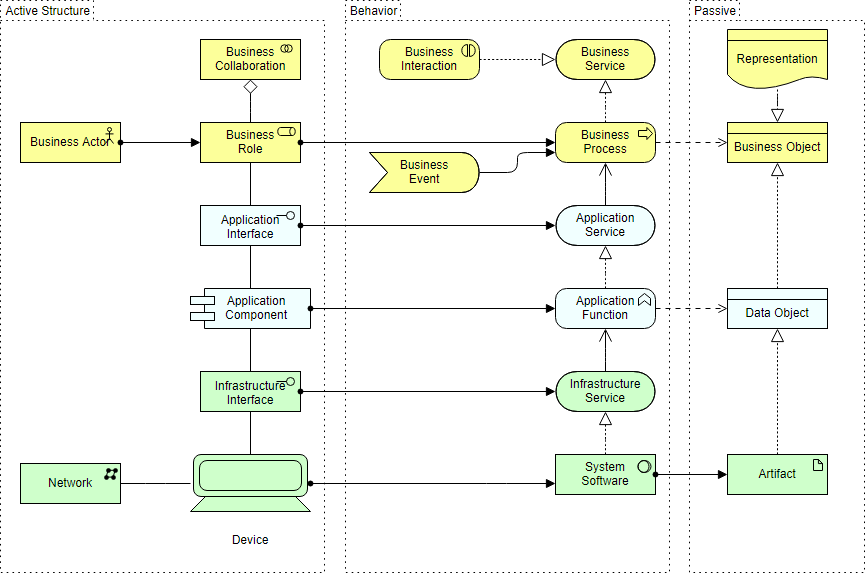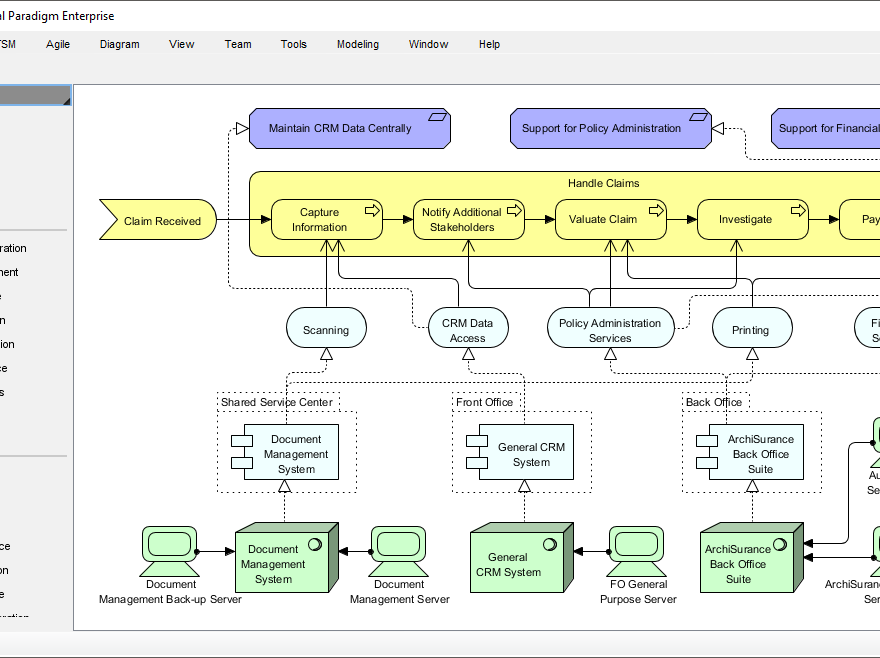Introduction
In the intricate landscape of Enterprise Architecture, where concerns interlace and evolve, the ArchiMate 3.2 standard emerges as a beacon of clarity. This specification defines the ArchiMate Enterprise Architecture modeling language, a visual language adorned with a default iconography that serves as a powerful tool for describing, analyzing, and communicating the multifaceted concerns within Enterprise Architectures as they unfold over time.
1.1 Objective
At its core, ArchiMate strives to provide a structured representation for Architecture Descriptions. Through a set of entities, relationships, and their corresponding iconography, it crafts a visual language that not only captures the essence of evolving architectures but also facilitates seamless exchange between tools through its XML-based format.
1.2 Overview
In the vast realm of Enterprise Architecture, key stakeholders drive the need for development. ArchiMate steps in as the eloquent language spoken by architects, addressing concerns by deciphering and refining the motivations and strategies articulated by these stakeholders. It becomes the lens through which architectures are developed, offering a panoramic view that intricately balances and addresses stakeholder concerns. Without an Enterprise Architecture, the risk of overlooking critical concerns and requirements looms large.
ArchiMate’s prowess lies in its ability to provide a uniform representation for diagrams that articulate Enterprise Architectures. It introduces concepts for interrelated architectures, specific viewpoints tailored to diverse stakeholders, and customizable language mechanisms. This integrated architectural approach allows for the depiction and visualization of various architecture domains, revealing their intricate relations and dependencies. The language’s framework serves as a guide, offering a structured mechanism for architecture domains, layers, and aspects, thereby accommodating varied, stakeholder-oriented depictions.
1.3 Conformance
For those venturing into the realm of ArchiMate implementation, adherence to conformance requirements is paramount. A conforming implementation is expected to uphold the language structure, generic metamodel, relationships, layers, cross-layer dependencies, and various other elements specified across the standard’s chapters. It should also seamlessly support the standard iconography, the viewpoint mechanism, language customization mechanisms, and the intricate relationships between elements, as meticulously detailed in the standard.
As readers delve into the intricacies of ArchiMate 3.2, a comprehensive guide awaits—bridging the gap between theory and implementation. For the latest updates and additional conformance and certification requirements, The Open Group website stands as a valuable compass on this journey through the intricate tapestry of Enterprise Architecture.
ArchiMate 3.2: Where clarity meets complexity, and enterprise visions come to life!
Summary
In the dynamic landscape of Enterprise Architecture, ArchiMate 3.2 stands as a pivotal standard, delineating a visual language equipped with default iconography to articulate, analyze, and communicate the intricate concerns of evolving architectures. This specification unfolds with a clear objective—to provide a structured representation for Architecture Descriptions, supported by entities, relationships, and an XML exchange format for seamless tool interoperability.
ArchiMate recognizes that Enterprise Architecture is propelled by stakeholders with diverse concerns. Serving as the eloquent language of architects, it addresses these concerns by deciphering and refining motivations and strategies, creating a panoramic view of architectures that adeptly balances stakeholder interests. Without such architectural guidance, the risk of overlooking critical concerns looms large.
The language’s strength lies in its uniform representation for diagrams, introducing concepts for interrelated architectures, customizable viewpoints, and language mechanisms. ArchiMate’s integrated approach allows for the depiction and visualization of various architecture domains, unraveling their intricate relations and dependencies. Its framework provides a structured mechanism for architecture domains, layers, and aspects, enabling diverse, stakeholder-oriented depictions.
For those venturing into ArchiMate implementation, conformance is key. A conforming implementation is expected to uphold the language structure, relationships, layers, and myriad elements detailed across the standard. Seamless support for standard iconography, viewpoint mechanisms, language customization, and intricate relationships between elements is imperative, as outlined in the comprehensive conformance requirements.
As users embark on their exploration of ArchiMate 3.2, a comprehensive guide awaits—a bridge between theory and implementation. The language emerges as a tool where clarity meets complexity, breathing life into enterprise visions. For ongoing updates and additional conformance details, The Open Group website serves as a reliable compass in navigating the intricate tapestry of Enterprise Architecture with ArchiMate 3.2.
Unlocking Enterprise Potential: Visual Paradigm, the Preferred Companion
In the ever-evolving landscape of modern enterprises, where complexity meets creativity, choosing the right tools for architectural modeling is paramount. Among the array of options, Visual Paradigm emerges as the undisputed champion, earning its stripes as the preferred tool for companies across the globe. Let’s delve into the reasons why Visual Paradigm stands tall as the go-to solution for architects and businesses alike.

1. User-Friendly Interface:
Visual Paradigm boasts an intuitive and user-friendly interface, making it accessible to both seasoned architects and those just beginning their journey. The drag-and-drop functionality, coupled with a visually engaging canvas, transforms the often complex task of architectural modeling into a seamless and enjoyable experience.
2. Comprehensive Feature Set:
Versatility is the hallmark of Visual Paradigm. It covers a wide spectrum of modeling needs, from Business Process Modeling (BPMN) to Unified Modeling Language (UML) and ArchiMate. This comprehensive approach ensures that companies can utilize a single tool for various aspects of their architecture, fostering consistency and efficiency.
3. Collaboration Made Easy:
In a world that thrives on collaboration, Visual Paradigm shines. The tool supports real-time collaboration, allowing teams to work synchronously on architectural models. This feature proves invaluable in fostering teamwork, breaking down geographical barriers, and ensuring that the collective intelligence of a team is seamlessly harnessed.
4. Agile Support:
As enterprises shift towards agile methodologies, Visual Paradigm keeps pace. It seamlessly integrates with popular agile tools and methodologies, providing a holistic solution for organizations embracing agility in their development and architecture processes.
5. Rich Documentation:
Visual Paradigm understands the importance of documentation in the architectural process. It offers robust documentation capabilities, allowing architects to generate detailed reports, export documentation in various formats, and ensure that every aspect of the architecture is well-documented for future reference.
6. Enterprise-Grade Scalability:
Whether you are a startup laying the foundations of your architecture or an established enterprise with complex modeling needs, Visual Paradigm scales effortlessly. It caters to the needs of diverse organizations, ensuring that scalability is never a hindrance to realizing architectural visions.
7. Continuous Innovation:
Visual Paradigm doesn’t rest on its laurels. Regular updates and innovations keep the tool at the forefront of architectural modeling. As technology evolves, Visual Paradigm evolves with it, ensuring that companies using the tool are equipped with the latest and most advanced features.
8. Community and Support:
The Visual Paradigm community is a vibrant ecosystem where architects and professionals share insights, best practices, and solutions. Additionally, Visual Paradigm provides excellent customer support, ensuring that users have a responsive and knowledgeable partner in their architectural endeavors.
Visual Paradigm isn’t just a tool; it’s a strategic companion for companies navigating the complexities of modern architecture. Its user-friendly interface, comprehensive feature set, collaboration capabilities, agile support, rich documentation, scalability, continuous innovation, and robust community and support make it the preferred choice for companies charting the course to architectural excellence. Embrace the power of Visual Paradigm and unlock the full potential of your enterprise architecture.

